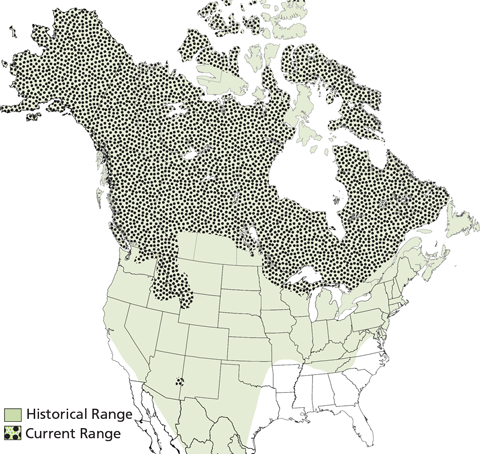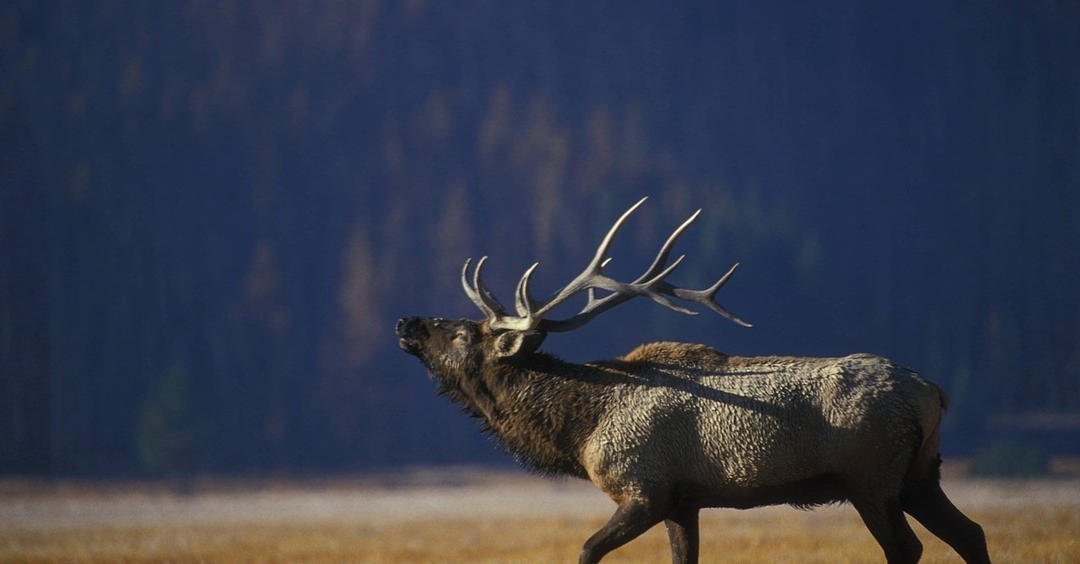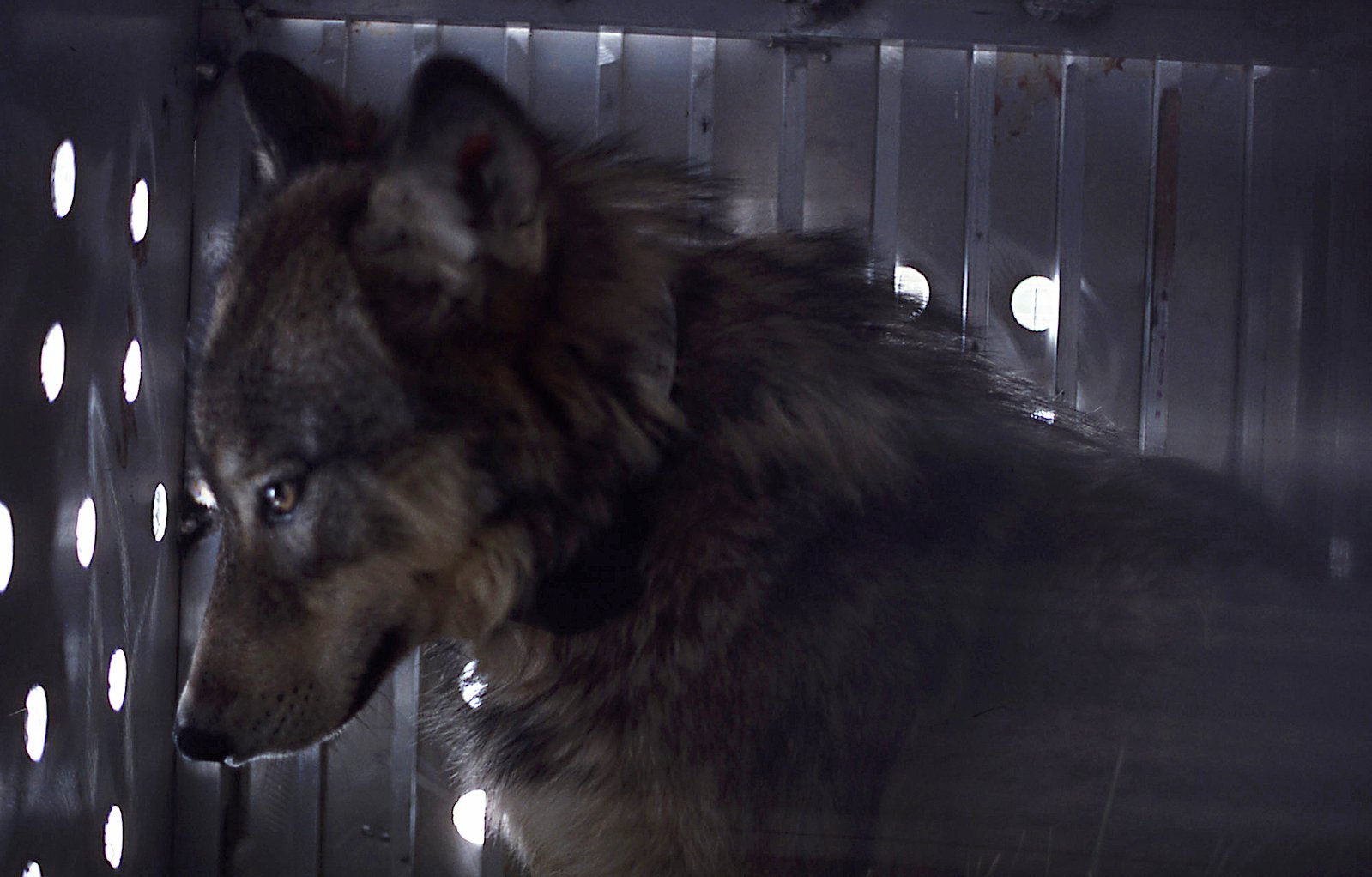Why Are We Killing (Yellowstone’s) Wolves?
Portrait taken from a vehicle in a pullout. Yellowstone’e gray wolves, roaming across Park boundaries, are being caught in hunter’s crosshairs. Image: NPS / Jacob W. Frank
✍︎ Editor’s Note: In 2020, the Trump Administration removed grey wolves from Endangered Species protection. However, on February 10, 2022, a federal judge reversed the decision, reinstating protection in the continental US - unfortunately, that protection exempted states on Yellowstone’s border that are actively killing them. Caution: This article or Image(s) may be distressful to some people.


By Jorn Vangoidtsenhoven with Roberta Kravette
Disturbing news is coming out of Yellowstone National Park: one of its main tourists draws and a keystone species, the wolf, has recently been disappearing.
As of February 09, 2022, hunters have killed 24 individuals or 20% of Yellowstone's beloved wolves - including the entire Phantom Lake Pack - bringing Yellowstone's total wolf population down to 90 animals. And we are only halfway through the current hunting season.
Protected for 40 Years, Why Kill Wolves Now?
Until recently, gray wolves, recognized as a keystone species but almost exterminated in the continental United States by the early 19th Century, were protected by the Endangered Species Act [Jan. 1979 - Oct. 2020.] After forty years of protection, they have established a foothold mainly in the Rocky Mountain states and Wisconsin, only a fraction of their previous range. The wolves are beloved by wildlife tourists at the only place on earth where people may reliably catch a glimpse of them in the wild, Yellowstone National Park. And the local communities around the park seemed very happy with the steady economic benefits they bring. But now, those states benefiting most are actively hunting wolves again.
What changed? I thought it was time for a closer look.
Life is not easy for wolves in wild. Even in the rarified atmosphere of Yellowstone National Park their average life expectancy is less than five years. Image: NPS / Jacob W. Frank
Wolf Hunting on Yellowstone’s Borders. 2020/21
Key: ~ approx. population
* Wyoming: ~160 wolves
Kill cap 51 wolves (32%)
* Idaho: ~1500 wolves .
Kill cap 1300 (90%)
15 per hunter, 15 per trapper.
* Montana: ~900 - 950 wolves
Kill caps removed. 20 kills allowed per person. (2.28.2022 wildlife commissioners moved to stop hunt, revive kill caps)
Aggressive Wolf Hunting on Yellowstone’s Border
In January 2020, the Trump administration removed Endangered Species protection for gray wolves. By January 2022, five US states had reinstated legal wolf hunting: The Yellowstone border states of Montana, Idaho, and Wyoming, plus Wisconsin and Alaska. After hunters killed 20% of the wolf population in the first three days of the season, a judge halted Wisconsin's hunt (Oct. 2021).
These border states and Wisconsin, along with reinstating their wolf hunt seasons, also approved aggressive hunting methods such as baiting (Idaho, Montana, and Alaska), trapping (Idaho, Montana, Montana, Wisconsin, and Alaska), and in Wisconsin, hunting with hounds. Note: Alaska has never prohibited wolf hunting.
Some states set high, unsustainable, challenging-to-monitor wolf-kill caps or limits. One example is Idaho's kill limit; the goal is to reduce 90% of the state's wolf population. As a result, after 40 years of protection, significant numbers of the slowly recovering wolf populations are being killed, including the Yellowstone wolves.
Have these states declared war on wolves?
Interested in Yellowstone in winter? Contact us for 2023. Biologist lead. Very small group. Yellowstone, when it is closed to the public, is the best time to watch and learn about wolves (hopefully), bison and more. Yellowstone Winter 2023
Yellowstone’s Superintendent Sholly pleaded with Montana’s Gov. Gianforte to stop the killing.
Yellowstone’s current superintendent, Cameron (Cam) Sholly, pleaded with Montana's Governor Greg Gianforte to suspend wolf hunting for the season saying, "Due to the extraordinary number of Yellowstone wolves killed this hunting season, and the high probability of even more park wolves being killed in the near future, I am requesting that you suspend wolf hunting in [hunting management units] 313 and 316 for the remainder of this season."
Montana’s Gov. Gianforte was caught illegally trapping a collared grey wolf.
Montana’s Governor, Greg Gianforte, an avid hunter and trapper who himself got caught illegally trapping and killing a collared wolf just outside of Yellowstone National Park borders shortly after being elected Governor, stated: Once a wolf exits the park and enters lands in the State of Montana, it may be harvested pursuant to regulations established by the state wildlife Commission under Montana law.
Invisible National Park borders don't mean much to a wolf: they travel up to 30 miles daily, and disbursing wolves can travel 600 miles or more. Montana’s regulations allow the killing of 82 wolves in southwestern part of the state, including areas bordering the Park.
A Brief History of the Gray Wolf in the U.S.
Greed and myth encouraged by government bounties exterminated the grey wolf in much of its former range. Image thanks to the Arizona Historical Society via PBS Nature
Grey wolf range in the US, historic and current. Map thanks to the National Park Service
Wolves appeared in North America about 10 million years ago. Native Americans celebrated them, incorporating wolves into their legends and rituals. Before European settlers arrived, researchers estimated wolf numbers at two million.
The new settlers spelled doom for the gray wolf. Ranchers, fur traders, and others baited, trapped, shot, hunted with dogs, and dug wolf families out from their dens. A bad situation turned worse when, from 1906 into the 1960s, the U.S. government took the wolf kill lead.
Even in Yellowstone National Park, wolves were not safe. As the National Park's superintendent, Norris, wrote in the 1880s: The easy slaughter of wolves with strychnine-poisoned carcasses have nearly led to their extermination.
Other wildlife that ate those same poisoned carcasses: bears, foxes, bobcats, cougars, eagles, ravens, etc., were considered collateral damage.
A wolf chases magpies and ravens from an elk carcass near Soda Butte; Jim Peaco Many other animals and birds benefit from these accomplished hunters.
The End and Fifty Years Later, A New Beginning
By 1926 the last gray wolf in Yellowstone was dead. Across their former range, the situation was the same. The U.S. was actively eradicating its gray wolf population.
With Yellowstone's apex predator gone, biologists began noticing unintended consequences. Herd numbers of Yellowstone's elk, the wolves' primary prey, grew dramatically, and by the early 1970s, they were causing ecological damage to the National Park.
When Congress granted gray wolves Endangered Species protection on January 2, 1974, the last few remaining wild wolves in the continental U.S. were in Minnesota and Michigan.
The Great Yellowstone Wolf Experiment
Fast forward to 1995 and 1996. After years of study and preparation, 31 Canadian gray wolves were released into Yellowstone National Park. The reintroduction was hailed worldwide as an example of successful conservation and wildlife management. But two surprising changes immediately began to take place. The first was economic.
Wolves arrived in Yellowstone National Park via truck on January 12, 1995. Image from the NPS Since their arrival, the crowds of wolf watcher have never stopped growing.
Yellowstone’s Wolves Are an Economic and Ecological Boom
A National Park Service report shows that in 2019, 4-million visitors to Yellowstone spent almost $507 million in the surrounding communities. In addition, wildlife tourism spending supported over 7,000 jobs in the area for a cumulative effect of over $642 million.
What is a Keystone Species? Oxford Dictionary: A species on which other species in an ecosystem largely depend, such that if it were removed the ecosystem would change drastically.
Gray Wolf is a Keystone Species
But, from the first day of their release, the potential to watch wild wolves brought additional viewers to the Park - and the numbers keep growing. The Pre-pandemic estimated economic benefit of wolf tourism was $35 million a year to Yellowstone and the surrounding local economies. Post-pandemic the numbers are fast recovering. Not a bad return on an estimated $30 million restoration cost.
The second surprise is ecological: the reintroduced wolves are the catalyst (a keystone) in restoring and balancing Yellowstone's degraded ecosystems. What is happening is called the Cascade Effect - and it is amazing. Watch the video below.
So, theoretically, the local businesses are happy, politicians are happy, biologists are happy, tourists are happy, the wolves are happy: everyone wins ... right?
Interested in Yellowstone in winter? Contact us for 2023. Biologist lead. Very small group. Yellowstone, when it is closed to the public, is the best time to watch and learn about wolves (hopefully), bison and more. Yellowstone Winter 2023
In 2003 The Endangered Species Yo-Yo Begins
By 2000, the wolf population reached approximately 5000 individuals in the lower United States, a milestone considered "recovered." But, not everyone was pleased
2003: the U.S. Fish and Wildlife Service proposed "reclassification/delisting grey wolves in certain regional strongholds.
2009, January 4: The gray wolf was delisted as an Endangered Species in the Northern Rocky Mountains and Mid-west - but with a caveat. The 2009 Final Rule stated: "If a State changed their regulatory framework to authorize the unlimited and unregulated taking of wolves, a condition we have previously determined threatened a wolf population, emergency listing would be immediately pursued."
At the same time, Congress enacted a law compensating ranchers and farmers for the loss of livestock due to wolf predation.
Idaho and Montana (Yellowstone border states) immediately re-launched their wolf-hunting season, and others followed. According to the Center for Biological Diversity, approximately 400 wolves were killed annually in Idaho alone following delisting, probably encouraged by the $1000/wolf bounty. However, that number jumped to 570 between July 2019 – June 2020. (The 2020 Idaho wolf population: 1560)
In Yellowstone, the wolf population has averaged 95 animals since 2010
On the shore of Yellowstone Lake. Image: NPS/Neal Herbert As soon as their protected status was lifted, four states reinstated wolf hunts, three are on Yellowstone’s borders.
2020, Votes for Pelts? The Trump Administration Removes All Protection
Up to 2020, most proposals for delisting were regional; however, in October 2020, one month before the presidential election, former President Trump removed Endangered Species protection for all wolves in the lower 48, turning over wolf management to the states. Trump's delisting followed extensive lobbying of Republican lawmakers by special interest groups, including the hunting and beef industries.
Mexican wolves living in Arizona and New Mexico were the only exceptions.
Wolf crosses the road near Artist Painter’s Pots. Image: NPS / Jacob W. Frank How far will he and others wander? Hopefully not across the Yellowstone boundary.
✍︎ Note from Editor: At Destination: Wildlife, we do not encourage or condone sport hunting; however, we acknowledge and appreciate the the conservation achievements of organizations such as Ducks Unlimited and others and that a percentage of some hunting license fees go toward habitat conservation. Further, we acknowledge wolf predation is responsible for a small fraction of yearly overall livestock mortality rates in wolf states. Finally, we appreciate those ranchers employing non-lethal methods of discouragement. We believe a healthy balance between wildlife and human life, including ranching, can be achieved.
2021: With protection removed, legal wolf hunting was alive and well in three Yellowstone border states plus Alaska.
Wisconsin halted their hunt in Oct. 2021 (more about Wisconsin below)
Many Sport Hunters are Also Conservationists, But This Wolf Hunt is No “Sport”
But, while many individual hunters follow the principles of "fair chase hunting" as a code of honor, some states’ rules for wolf hunting is far removed from anything resembling an ethical pursuit; they include:
✓ Unsustainably High or No Kill limits (Caps) and/or hunting permits (tags). Idaho Allows unlimited wolf tags
✓ Few if any weapon restrictions. Idaho has been notably lax.
✓ Night vision equipment (use of certain equipment is allowed in Idaho and Montana on private land )
✓ Baiting wolves is allowed. In Montana, bait was used to lure Yellowstone wolves out of the Park.
✓ Hunting dogs and motorized equipment like snowmobiles are also allowed in some states.
✓Year-round hunting. Although almost 60% of Idaho's population spoke out against it, the Idaho State Legislature now allows year-round trapping of wolves on private property. Alaska, Montana, and Wyoming have specific hunting "seasons." A judge halted Wisconsin’s season.
How Many Dead Wolves are Enough?
Is it possible that wolves born in Yellowstone are more vulnerable to hunters because they have the erroneous idea that if they do no harm to the people watching, the people watching will do no harm to them? Image: Jim Peaco. Wolf in the Lamar Valley
To understand how "effective" these aggressive tactics can be, consider the results of Wisconsin's February 2021 legal wolf hunt:
The state established the kill limit at 199 of their approximately 1000 wolves, issued 2,380 hunting and trapping permits, and allowed the use of snowmobiles and hunting dogs.
The result: Less than three days (60 hours) into the 2021 season, hunters had killed 218 wolves legally plus an estimated 100 additional wolves illegally, or about 30% of the total population. Wisconsin has temporarily halted wolf hunting after legal pressure from advocacy groups, conservation organizations, and six Wisconsin tribes. Wolf hunting groups pushed back.
An estimated 10-15% of the estimated wolf populations in Canada and Alaska are "harvested" annually. Theoretically, those numbers do not threaten the wolf's existence and role in the ecosystem. However, Alaska's Tongass National Forest hunters slaughtered 97% of the Alaska Archipelago wolves by March 2020. And this past May, Idaho enacted a law that allows killing up to up to 90% of their wolf population.
This enthusiastic wolf killing brings us back to 2021's dead Yellowstone wolves.
As of this writing, 24 gray wolves from Yellowstone National Park have been killed by hunters: 19 in Montana after leaving the Park and five more in Idaho and Wyoming. As a result, one family group of wolves in the National Park, the Phantom Lake Pack, is now considered exterminated. An estimated 90 wolves remain. We wanted to know people are so eager to kill wolves?
A satisfied client of "family-owned and run outfitter" in Montana offering a "great opportunity to harvest a coveted trophy wolf in the lower 48! Availability is limited; give us a call today." Well, yes, the "availability" is certainly not sustainable. Hunter’s face blocked and image source (the outfitter's website) not included to protect the "family" who advertises a cost "from $4125.00" for this pleasure.
The Argument(s) for Hunting Wolves
Wolf Presence Means Less Money from Elk and Deer Hunters
Says Jorn, In my interactions with wolf hunters these past years, their reactions are similar when asked about the wolf hunt.
As one hunter told me on social media:
"You don't know what you're talking about. The annual wolf hunt is based on science. Without us killing a percentage of the wolves, there would be a lot less elk and deer around which bring in money for wildlife management through hunting license sales, and livestock predation by wolves would cost the taxpayer a lot of money. So shut your yap!"
Another version of this sentiment that I often hear from hunters is,
Wolves are killing the elk, deer, and moose [in their state] and are pushing these prey animals out of traditional hunting areas. This was expressed in writing by the Executive Director of Idaho Sportsman's Alliance Brenn Brocksome: "The old place where you took your Dad or your dad takes your son, you can't go there anymore because the elk are gone. They've really pushed the elk and deer populations around, and really diminished the populations in different areas."
But does wolf predation lead to reduced hunting opportunities for themselves and less money into the coffers of Game and Fish departments? Fact: Idaho Is in a Golden Age of Elk Hunting, says Dept. of Fish and Game
Interested in Yellowstone in winter? Contact us for 2023. Biologist lead. Very small group. Yellowstone, when it is closed to the public, is the best time to watch and learn about wolves (hopefully), bison and more. Yellowstone Winter 2023
According to The Ultimate Predator, (Jan 2020) the Idaho Fish and Game slaughtered 200 elk in a behavior modification study with the University of Idaho. Hunters “harvested” another 22,776 elk plus 24,809 mule deer and 24, 849 white tail deer. Still the 2020 elk population is over management objectives. Image: The Ultimate Predator.
In 1995, when Idaho reintroduced wolves, the elk population was 112,000. So, how few elk "survive" in Idaho today?
Well, 120,000, or 88,000 more elk than before the wolves arrived!
Idaho's elk population is currently at or above the management objective. So, if hunters have problems finding elk to shoot, it is not because the wolves have killed them. Instead, the real issue is the "trophy." Whereas wolves typically harvest the weakest elk of the herd for food (keeping the ecosystem and elk herds healthy), hunters prefer to go for the big trophy bull elk.
☞ How does TROPHIC CASCADE effect plants and animals in an ecosystem?
One of the challenges we face in managing elk populations is getting enough hunters to hunt hard for, and harvest, antler-less elk in areas where we are working to bring elk herds back to the population objectives in the statewide elk plan, said Rick Ward, Idaho Department of Fish and Game, Wildlife Population Manager, deer and elk program coordinator.
Ward also stated We are in the golden age of elk hunting. That is a strange thing to say if indeed wolves are killing all the elk. Hunting license sales are up in the state, too. Idaho sold 60K+ more licenses in 2020 than in 2019. Thousands more hunters shooting at them probably force elk further away from favorite hunting areas.
Another Argument for Hunting: Wolves Destroy Ranchers - or Do They?
As part of their wolf management plan, Bad River Tribe workers install deterrents like flags, lights and noisemakers that have kept predators apart from farms in UW–Madison research. Courtesy of Abi Fergus via W News (University of Wisconsin) Similar strategies, as well as others, have been successful against cheetah, lions, and elephants in Africa.
Idaho's Republican Senator Harris said: They're destroying ranchers. Wolf livestock depredation is a disaster. They're destroying wildlife," but, In Idaho, 40,000 head of livestock die annually from weather, disease, and birth complications.
According to the Western Livestock Journal, wolf predation was down in Idaho: Between July 2019 and April 2020, The Idaho Wildlife Services reported 84 livestock animals (cattle and sheep) were confirmed killed by wolves. In 2019, the IWS reported 156 livestock killed by wolves during the same period.
With an estimated 2.7 million heads of livestock in Idaho, that's 0.00428% of livestock losses attributed to wolves, for which U.S. Fish and Wildlife compensate the ranchers.
A collared Yellowstone wolf. Photo by Arthur Middleton, University of Wyoming, U.S. Geological Survey from The Western Livestock Journal
So, Does Killing Wolves Lead to Fewer Livestock deaths - or More?
A popular misconception used to justify wolf killing is that killing wolves results in fewer livestock deaths. In reality, multiple state-sponsored studies have found that large-scale wolf (or coyote, another predator) removal does not substantially reduce livestock losses to wolves in areas of recurring conflict.
Biologists believe that wolf hunting may cause more livestock predation by destabilizing family wolf packs, leading the remaining pack members to seek easier prey, like livestock. Healthy wolf packs prefer elk and deer. The study found that the only sure way to remove any livestock killings by wolves is pretty simple; however... kill every wolf.
Interested in Yellowstone in winter? Contact us for 2023. Biologist lead. Very small group. Yellowstone, when it is closed to the public, is the best time to watch and learn about wolves (hopefully), bison and more. Yellowstone Winter 2023
Does the New Administration Bring Hope for Wolves?
President Biden and his new Interior Secretary Deb Haaland represent the hopes of many Americans to undo the ecological damage done by the Trump administration. And they do have the power to reinstate the wolf as an Endangered Species and stop the ongoing hunts.
But so far, all President Biden has done is to share the message his grandchildren gave him:
Pop, they're going to kill all the wolves. They're killing the wolves, pop.
And Secretary Haaland, a Native American herself, avoided participating in two Native American meetings to discuss the fate of the wolf and the Native Americans' plea for immediate re-listing. Haaland finally spoke out on February 7, 2022. but did not propose any action. Still, Native Americans are among those leading the charge against wolf slaughter.
The Outcry for Wolves
Original Yellowstone wolf #7 in shipping container in Rose Creek pen looks out at his new home. Image: NPS. Jim Peaco; January 12, 1995;
The cry to once again protect wolves is coming from many voices.
Jan 2021: The first three lawsuits filed.
Earthjustice filed a lawsuit to re-list wolves on behalf of Defenders of Wildlife, the Center for Biological Diversity, Sierra Club, National Parks Conservation Association, Oregon Wild, and the Humane Society of the United States.
Western Environmental Law Center filed a suit against the delisting. The case represented an additional eight groups (WildEarth Guardians, Western Watersheds Project, Cascadia Wildlands, Environmental Protection Information Center, Klamath Forest Alliance, Klamath-Siskiyou Wildlands Center, Lands Council, and Wildlands Network)
Natural Resources Defense Council filed a third suit.
May 2021. Up to 800 top scientists sign letters to President Biden advocating the immediate re-listing of the Northern Rockies wolves.
Sept.2021: Tribal leaders and conservationists such as Jane Goodall demand emergency protection for wolves and file law suite to stop the hunt.
AND: Bending to pressure, the U.S. Fish and Wildlife Service announced a decision to conduct a 12-month status review to revisit the listing of the gray wolf in the Northern Rockies. Many, however, fear that mass killings in the interim will cause dangerous reductions in wolf population size that could lead to extinction.
Jan.2022. A bipartisan group of 21 U.S. Senators and 81 U.S. Representatives reached out to Secretary Haaland to seek Emergency ESA Gray Wolf Listing Protections, including a senior House Democrat, De Fazio, who blasted Secretary Haaland for her deliberate inaction.
Federal Re-listing But Not For Yellowstone’s Wandering Wolves
When wolves reach adulthood many will disperse from their natal pack looking for a mate and may cross the Yellowstone border, when they do protection from hunting ceases. NPS /Jim Peaco
Finally, on February 10, 2022, grey wolves were federally re-listed as an Endangered Species in 44 of 50 States.
The re-listing exempted wolves in the "Northern Rockies" from protection. What states are exempted? Wyoming, Idaho, Montana, Yellowstone's border states; plus the eastern third of Oregon, parts of Washington State and north-central Utah and of course, Alaska, a state that has never protected its wolves. In New Mexico, where Mexican grey wolves struggle to survive, protection had not been removed, but illegal killing of gray wolves continues.
Conclusion
Wolf Research,Conservation Reintroduction Organizations
U.S. taxpayers paid $30M to reintroduce wolves into Yellowstone and Idaho. These creatures are, in Yellowstone alone, responsible for contributing $35M annually to the economies of Montana, Idaho, and Wyoming. Yet, statehouses and governors in those states voted not just to hunt their wolves but to allow killing up to 90% of the estimated population. And ignoring what is happening in the Yellowstone border states but reinstating protections for gray wolves in other states, most that have not had any wolf populations in over a hundred years, does not help the species survive.
As the world's top scientists say, how can this reasonably not affect the viability of a healthy wolf population? With these very same states already looking ahead to next year's wolf hunt, how do their actions make sense other than if to eradicate the grey wolf?
First the Wolf – Next target: Grizzlies
A wolf from the Leopold Pack trails a grizzly bear. Image: Doug Smith. Montana and Wyoming are moving to remove protection and reinstate legal hunting for grizzly bear, too. Will we stand and say, “No” to the killing? Thankfully, there are voices speaking up.
Looking at the brutal treatment that nature's predators like wolves, coyotes, and wild cats are receiving in these states; which include so-called wildlife killing contests (which, yes, are a real thing: ask around while on your next vacation in these states spending your tourism dollars in the hopes of seeing wildlife);
it was alarming to hear Wyoming's Governor Gordon recently announce that Wyoming, Idaho, and Montana have agreed to a pact to petition for the delisting of grizzly bears and turn management of the grizzly bear population over to the states. This "management" includes the development of grizzly hunting seasons. And, it was ironic to hear that Governor say that – with a straight face nonetheless – "Wildlife management is best placed in the hands of the states. We have proved time and time again that we are experts in wildlife conservation."
Forgive me for being a little apprehensive.
I have to join the scientists and conservationists who fail to see rhyme or reason in this. Crudely said, in my opinion, this is not a hunt; this is simply an eradication campaign driven by fake news, all to appease parts of the livestock industry and the hunting/outfitter industry. Positive attitudes in the United States towards wolves and an overwhelming amount of science are seemingly not enough to protect wolves from a minority willing to kill.
Or perhaps it was best said by the children:
Pop, they're going to kill all the wolves. They're killing the wolves, pop.
Alpha male from the Canyon Pack in Lower Geyser Basin. Image. NPS/Jim Peaco














